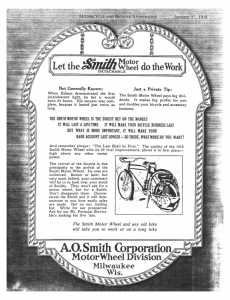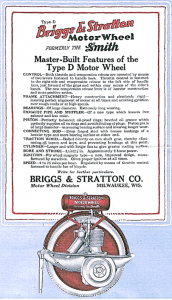Introduction
Motor Wheel
About 1912, A. W. Wall of the Roe Motorcycle Works in Surrey. England, devised a bolt-on power attachment for bicycles. The Wall Auto Wheel drove a wheel by chain from the camshaft. The engine unit was mounted in a pivoting frame and attached to the rear of an ordinary bicycle frame so that the bicycle could be banked on corners.
In 1914, the Smith Company of Milwaukee acquired the rights to build the Wall Auto Wheel and improved the design in several respects, including changing the wire-spoked powered wheel with a disc wheel. The Smith Motor Wheel proved to be a success. A Motor Wheel was even fitted at the rear of a rudimentary cycle car – the Flyer – one of the few five-wheeled cars ever manufactured. The axles were directly bolted to six wooden planks that acted as floor, chassis and suspension – the traditional buckboard design.
Briggs & Stratton bought the productions rights for the Motor Wheel and the Flyer in 1919. The engine was increased in power from l to 2 hp and fitted with a flywheel magneto.
Briggs & Stratton Buckboard Flyer
The Motor Wheel-powered buckboard was first introduced in America by the A. O. Smith Company in 1917. Briggs & Stratton took over production in 1919, producing the Briggs & Stratton Flyer from 1919 until 1924 with “Young America” as its target customer. The Flyer consists of a buckboard with four wire wheels equipped with pneumatic rubber tires. The slats are made of American ash, providing adequate resiliency over rough roads. The two wooden bucket seats are upholstered in Morrocoline leather. The wheel base is 62 inches; the overall length with motor attached is 98 inches.
The Flyer is powered by a one-cylinder, four-cycle; air-cooled 2 Hp engine. The traction wheel is bolted directly on the camshaft. The gas tank holds one-half gallon, sufficient for 40 to 50 miles. The Motor Wheel is equipped with a belt-driven cooling fan, operated from the fly wheel. The fan was used only on the Flyer. Braking is accomplished by lifting the Motor Wheel off the ground and pressing the brake pedal, there by pushing the back fenders against the back wheels, stopping the buckboard.
Early advertising states:
“Just imagine riding over 80 miles on one gallon of gasoline, at a rate of between 4 and 25 miles an hour, along some delightful boulevard or over a picturesque country road with a charming young lady for companion. Nowhere is greater pleasure and practicability to be had for such a small investment…” The Flyer sold for $175.00 in 1919.
The Briggs & Stratton Scooter
The Briggs & Stratton Corporation introduced the first American built Motor Scooter in late 1920. Early advertising directed toward dealers states:
The rear wheel is a standard Briggs-Stratton Motor Wheel – a tried and proved success from every standpoint of durability, simplicity and economy. The Motor Scooter gives the extraordinary mileage of 100 miles per gallon with a speed range from 3 to 25 miles per hour. The wheels are 20 inches in diameter, giving a low center of gravity which makes riding easy, safe and simple. The cutout frame makes the Motor Scooter very comfortable to ride. It includes a foot brake that facilitates stopping and handling in traffic. A large double acting spring seat and spring foot board provide ease and comfort in riding. The control is on the handlebars. You simply push the Motor Scooter a few feet to crank – hop on and scoot away.
The Motor Scooter’s market is practically every man, woman and child in America. It is so clean and safe and convenient that it is the ideal solution of the individual pleasure riding problem. Its economy, durability and faithful service make it a wonderful asset to merchants for light delivery and messenger service.





